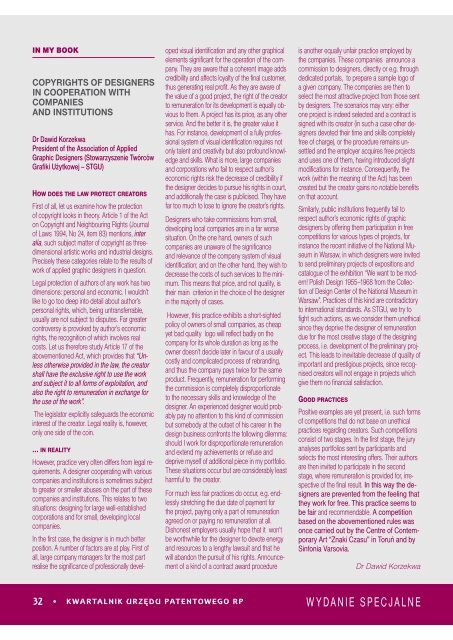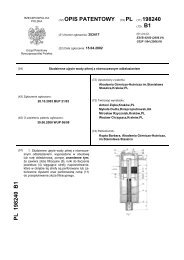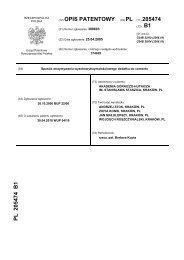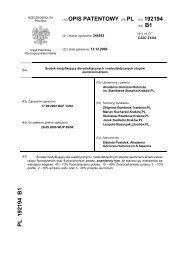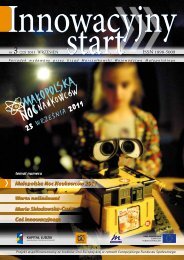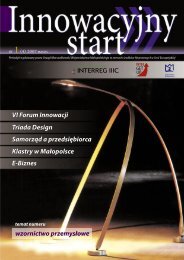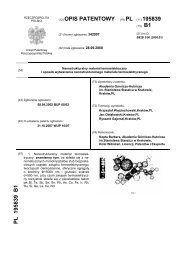Wyd. specjalne/2011 - Regionalny OÅrodek Informacji Patentowej ...
Wyd. specjalne/2011 - Regionalny OÅrodek Informacji Patentowej ...
Wyd. specjalne/2011 - Regionalny OÅrodek Informacji Patentowej ...
- No tags were found...
Create successful ePaper yourself
Turn your PDF publications into a flip-book with our unique Google optimized e-Paper software.
IN MY BOOKCOPYRIGHTs OF DESIGNERSIN COOPERATION WITHCOMPANIESAND INSTITUTIONSDr Dawid KorzekwaPresident of the Association of AppliedGraphic Designers (Stowarzyszenie TwórcówGrafiki Użytkowej – STGU)How does the law protect creatorsFirst of all, let us examine how the protectionof copyright looks in theory. Article 1 of the Acton Copyright and Neighbouring Rights (Journalof Laws 1994, No 24, item 83) mentions, interalia, such subject matter of copyright as threedimensionalartistic works and industrial designs.Precisely these categories relate to the results ofwork of applied graphic designers in question.Legal protection of authors of any work has twodimensions: personal and economic. I wouldn’tlike to go too deep into detail about author’spersonal rights, which, being untransferrable,usually are not subject to disputes. Far greatercontroversy is provoked by author’s economicrights, the recognition of which involves realcosts. Let us therefore study Article 17 of theabovementioned Act, which provides that “Unlessotherwise provided in the law, the creatorshall have the exclusive right to use the workand subject it to all forms of exploitation, andalso the right to remuneration in exchange forthe use of the work”.The legislator explicitly safeguards the economicinterest of the creator. Legal reality is, however,only one side of the coin.… in realityHowever, practice very often differs from legal requirements.A designer cooperating with variouscompanies and institutions is sometimes subjectto greater or smaller abuses on the part of thesecompanies and institutions. This relates to twosituations: designing for large well-establishedcorporations and for small, developing localcompanies.In the first case, the designer is in much betterposition. A number of factors are at play. First ofall, large company managers for the most partrealise the significance of professionally developedvisual identification and any other graphicalelements significant for the operation of the company.They are aware that a coherent image addscredibility and affects loyalty of the final customer,thus generating real profit. As they are aware ofthe value of a good project, the right of the creatorto remuneration for its development is equally obviousto them. A project has its price, as any otherservice. And the better it is, the greater value ithas. For instance, development of a fully professionalsystem of visual identification requires notonly talent and creativity but also profound knowledgeand skills. What is more, large companiesand corporations who fail to respect author’seconomic rights risk the decrease of credibility ifthe designer decides to pursue his rights in court,and additionally the case is publicised. They havefar too much to lose to ignore the creator’s rights.Designers who take commissions from small,developing local companies are in a far worsesituation. On the one hand, owners of suchcompanies are unaware of the significanceand relevance of the company system of visualidentification; and on the other hand, they wish todecrease the costs of such services to the minimum.This means that price, and not quality, istheir main criterion in the choice of the designerin the majority of cases.However, this practice exhibits a short-sightedpolicy of owners of small companies, as cheapyet bad quality logo will reflect badly on thecompany for its whole duration as long as theowner doesn’t decide later in favour of a usuallycostly and complicated process of rebranding,and thus the company pays twice for the sameproduct. Frequently, remuneration for performingthe commission is completely disproportionateto the necessary skills and knowledge of thedesigner. An experienced designer would probablypay no attention to this kind of commissionbut somebody at the outset of his career in thedesign business confronts the following dilemma:should I work for disproportionate remunerationand extend my achievements or refuse anddeprive myself of additional piece in my portfolio.These situations occur but are considerably leastharmful to the creator.For much less fair practices do occur, e.g. endlesslystretching the due date of payment forthe project, paying only a part of remunerationagreed on or paying no remuneration at all.Dishonest employers usually hope that it won’tbe worthwhile for the designer to devote energyand resources to a lengthy lawsuit and that hewill abandon the pursuit of his rights. Announcementof a kind of a contract award procedureis another equally unfair practice employed bythe companies. These companies announce acommission to designers, directly or e.g. throughdedicated portals, to prepare a sample logo ofa given company. The companies are then toselect the most attractive project from those sentby designers. The scenarios may vary: eitherone project is indeed selected and a contract issigned with its creator (in such a case other designersdevoted their time and skills completelyfree of charge), or the procedure remains unsettledand the employer acquires free projectsand uses one of them, having introduced slightmodifications for instance. Consequently, thework (within the meaning of the Act) has beencreated but the creator gains no notable benefitson that account.Similarly, public institutions frequently fail torespect author’s economic rights of graphicdesigners by offering them participation in freecompetitions for various types of projects, forinstance the recent initiative of the National Museumin Warsaw, in which designers were invitedto send preliminary projects of expositions andcatalogue of the exhibition “We want to be modern!Polish Design 1955–1968 from the Collectionof Design Center of the National Museum inWarsaw”. Practices of this kind are contradictoryto international standards. As STGU, we try tofight such actions, as we consider them unethicalsince they deprive the designer of remunerationdue for the most creative stage of the designingprocess, i.e. development of the preliminary project.This leads to inevitable decrease of quality ofimportant and prestigious projects, since recognisedcreators will not engage in projects whichgive them no financial satisfaction.Good practicesPositive examples are yet present, i.e. such formsof competitions that do not base on unethicalpractices regarding creators. Such competitionsconsist of two stages. In the first stage, the juryanalyses portfolios sent by participants andselects the most interesting offers. Their authorsare then invited to participate in the secondstage, where remuneration is provided for, irrespectiveof the final result. In this way the designersare prevented from the feeling thatthey work for free. This practice seems tobe fair and recommendable. A competitionbased on the abovementioned rules wasonce carried out by the Centre of ContemporaryArt “Znaki Czasu” in Toruń and bySinfonia Varsovia.Dr Dawid Korzekwa32 • KWARTALNIK URZĘDU PATENTOWEGO RP <strong>Wyd</strong>anie <strong>specjalne</strong>


